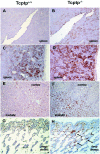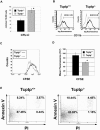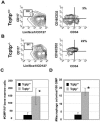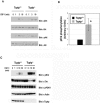T-cell protein tyrosine phosphatase (Tcptp) is a negative regulator of colony-stimulating factor 1 signaling and macrophage differentiation
- PMID: 16705167
- PMCID: PMC1489091
- DOI: 10.1128/MCB.01932-05
T-cell protein tyrosine phosphatase (Tcptp) is a negative regulator of colony-stimulating factor 1 signaling and macrophage differentiation
Abstract
Mice null for the T-cell protein tyrosine phosphatase (Tcptp-/-) die shortly after birth due to complications arising from the development of a systemic inflammatory disease. It was originally reported that Tcptp-/- mice have increased numbers of macrophages in the spleen; however, the mechanism underlying the aberrant growth and differentiation of macrophages in Tcptp-/- mice is not known. We have identified Tcptp as an important regulator of colony-stimulating factor 1 (CSF-1) signaling and mononuclear phagocyte development. The number of CSF-1-dependent CFU is increased in Tcptp-/- bone marrow. Tcptp-/- mice also have increased numbers of granulocyte-macrophage precursors (GMP), and these Tcptp-/- GMP yield more macrophage colonies in response to CSF-1 relative to wild-type cells. Furthermore, we have identified the CSF-1 receptor (CSF-1R) as a physiological target of Tcptp through substrate-trapping experiments and its hyperphosphorylation in Tcptp-/- macrophages. Tcptp-/- macrophages also have increased tyrosine phosphorylation and recruitment of a Grb2/Gab2/Shp2 complex to the CSF-1R and enhanced activation of Erk after CSF-1 stimulation, which are important molecular events in CSF-1-induced differentiation. These data implicate Tcptp as a critical regulator of CSF-1 signaling and mononuclear phagocyte development in hematopoiesis.
Figures








Similar articles
-
Macrophages from motheaten and viable motheaten mutant mice show increased proliferative responses to GM-CSF: detection of potential HCP substrates in GM-CSF signal transduction.Exp Hematol. 1997 Jul;25(7):592-600. Exp Hematol. 1997. PMID: 9216734
-
Scaffolding protein Gab2 mediates differentiation signaling downstream of Fms receptor tyrosine kinase.Mol Cell Biol. 2001 May;21(9):3047-56. doi: 10.1128/MCB.21.9.3047-3056.2001. Mol Cell Biol. 2001. PMID: 11287610 Free PMC article.
-
Regulation of colony-stimulating factor 1 receptor signaling by the SH2 domain-containing tyrosine phosphatase SHPTP1.Mol Cell Biol. 1996 Jul;16(7):3685-97. doi: 10.1128/MCB.16.7.3685. Mol Cell Biol. 1996. PMID: 8668185 Free PMC article.
-
Biology and action of colony--stimulating factor-1.Mol Reprod Dev. 1997 Jan;46(1):4-10. doi: 10.1002/(SICI)1098-2795(199701)46:1<4::AID-MRD2>3.0.CO;2-V. Mol Reprod Dev. 1997. PMID: 8981357 Review.
-
Regulation of cell cycle entry and G1 progression by CSF-1.Mol Reprod Dev. 1997 Jan;46(1):11-8. doi: 10.1002/(SICI)1098-2795(199701)46:1<11::AID-MRD3>3.0.CO;2-U. Mol Reprod Dev. 1997. PMID: 8981358 Review.
Cited by
-
Gab2 deficiency suppresses high-fat diet-induced obesity by reducing adipose tissue inflammation and increasing brown adipose function in mice.Cell Death Dis. 2021 Feb 26;12(2):212. doi: 10.1038/s41419-021-03519-9. Cell Death Dis. 2021. PMID: 33637697 Free PMC article.
-
A functional framework for interpretation of genetic associations in T1D.Curr Opin Immunol. 2012 Oct;24(5):516-21. doi: 10.1016/j.coi.2012.07.003. Epub 2012 Jul 26. Curr Opin Immunol. 2012. PMID: 22841349 Free PMC article. Review.
-
An Ehrlichia chaffeensis tandem repeat protein interacts with multiple host targets involved in cell signaling, transcriptional regulation, and vesicle trafficking.Infect Immun. 2009 May;77(5):1734-45. doi: 10.1128/IAI.00027-09. Epub 2009 Mar 9. Infect Immun. 2009. PMID: 19273555 Free PMC article.
-
Loss of T-cell protein tyrosine phosphatase in the intestinal epithelium promotes local inflammation by increasing colonic stem cell proliferation.Cell Mol Immunol. 2018 Apr;15(4):367-376. doi: 10.1038/cmi.2016.72. Epub 2017 Mar 13. Cell Mol Immunol. 2018. PMID: 28287113 Free PMC article.
-
CKIP-1 regulates macrophage proliferation by inhibiting TRAF6-mediated Akt activation.Cell Res. 2014 Jun;24(6):742-61. doi: 10.1038/cr.2014.53. Epub 2014 Apr 29. Cell Res. 2014. PMID: 24777252 Free PMC article.
References
-
- Alberola-Ila, J., and G. Hernandez-Hoyos. 2003. The Ras/MAPK cascade and the control of positive selection. Immunol. Rev. 191:79-96. - PubMed
-
- Alessi, D. R., S. R. James, C. P. Downes, A. B. Holmes, P. R. Gaffney, C. B. Reese, and P. Cohen. 1997. Characterization of a 3-phosphoinositide-dependent protein kinase which phosphorylates and activates protein kinase Bα. Curr. Biol. 7:261-269. - PubMed
-
- Austyn, J. M., and S. Gordon. 1981. F4/80, a monoclonal antibody directed specifically against the mouse macrophage. Eur. J. Immunol. 11:805-815. - PubMed
-
- Bartelmez, S. H., T. R. Bradley, I. Bertoncello, D. Y. Mochizuki, R. J. Tushinski, E. R. Stanley, A. J. Hapel, I. G. Young, A. B. Kriegler, and G. S. Hodgson. 1989. Interleukin 1 plus interleukin 3 plus colony-stimulating factor 1 are essential for clonal proliferation of primitive myeloid bone marrow cells. Exp. Hematol. 17:240-245. - PubMed
-
- Berg, K. L., K. A. Siminovitch, and E. R. Stanley. 1999. SHP-1 regulation of p62(DOK) tyrosine phosphorylation in macrophages. J. Biol. Chem. 274:35855-35865. - PubMed
Publication types
MeSH terms
Substances
Grants and funding
LinkOut - more resources
Full Text Sources
Other Literature Sources
Molecular Biology Databases
Research Materials
Miscellaneous
